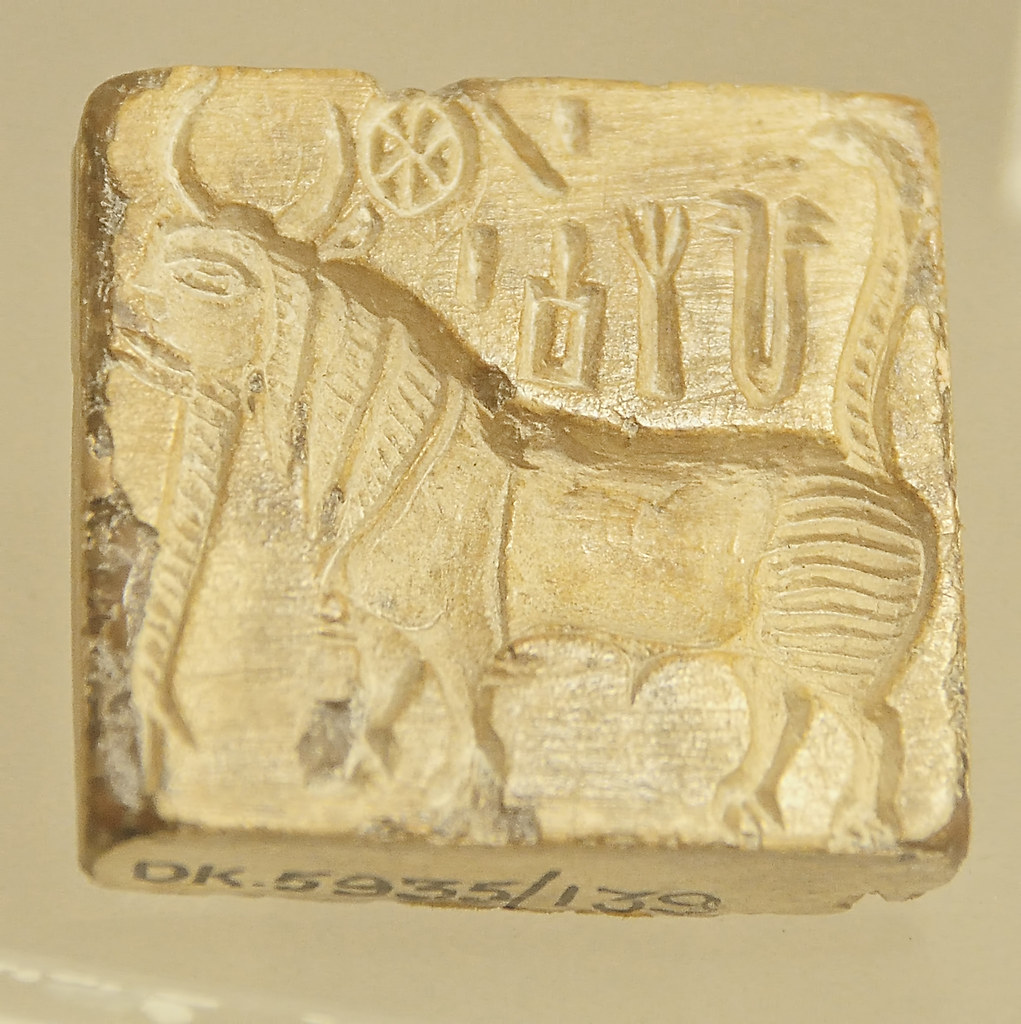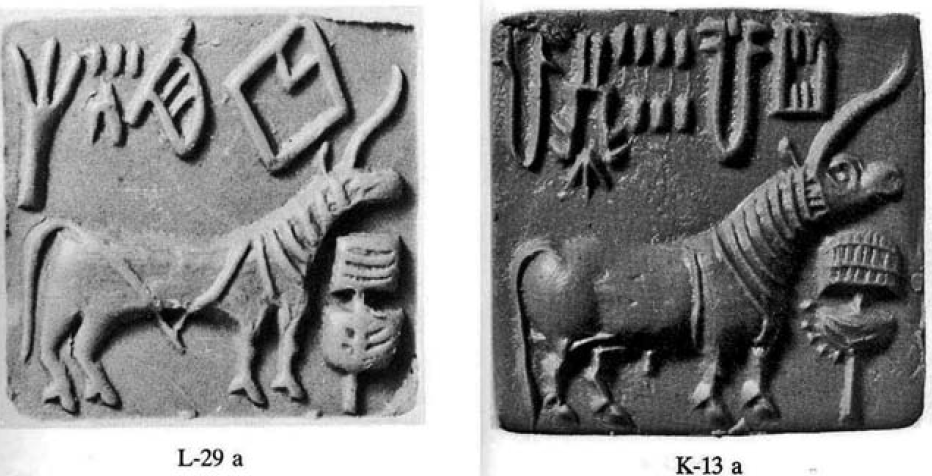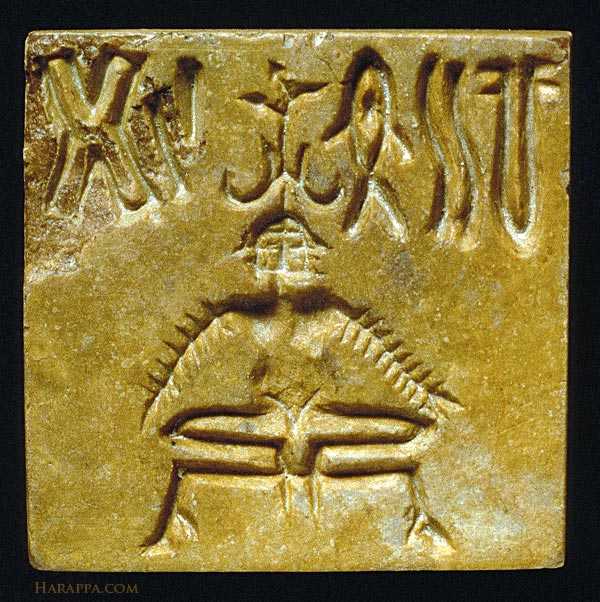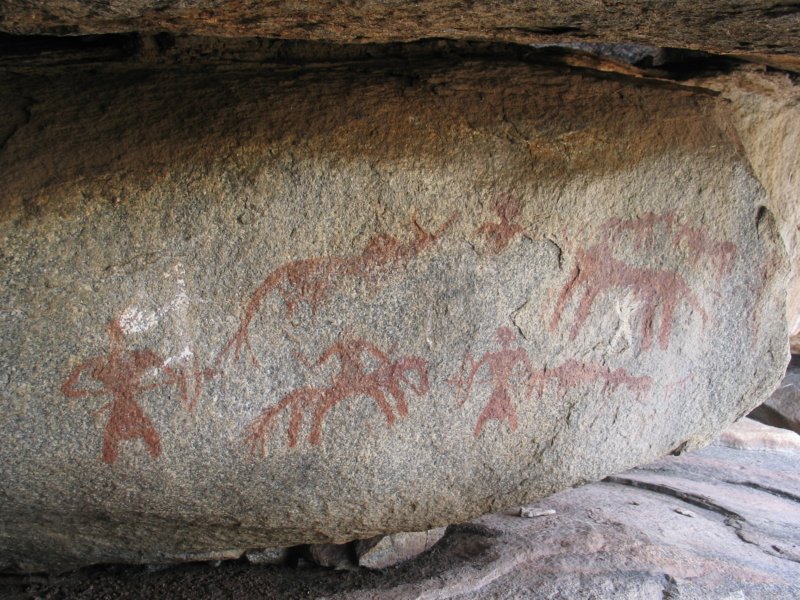
Unicorn and missing horse in Harappan Seals
Unicorn seal is the first seal found in harappan excavation. It is widely collected from different Indus valley sites. Western scholars think, this unicorn is a mythological animal as no biological remains (like bones) were ever found for a single horn animal resembling the description of unicorn in the world.
There is an interesting question. Why everyone thinks the "horn" as a "real horn"? Why not evaluate alternate paths? As this unicorn is depicted in a ceremonial setting, the horn could be a decoration to the animal (as other decorations observed on its neck and back can be observed) also.
May be a horse without horn looked odd to Harpans, so they might have decided to decorate the missing piece from gods creation. No proof (like bones) of any unicorn is ever found on earth. It is highly possible that, the ceremonial "horn" may have given rise to a story on "unicorn" in olden time itself. The "rushyashrunga" of ramayan itself might have based on such an idea. Without the horn the animal resembles a horse (due to pattern on neck).
Harappan elephant also seen with decorations (observe pattersn around neck). As seals were used for trading, it was something like a 'trade license'. The sybol on trade license could mean royal emblems or royal animals. Royal animals always comes with royal decorations. So Be it Elephant, Tiger, Bull, Horse, Rhino or Antelope, they are 'Royal" animals belonging to to Head of state. So, the corn on the horse is nothing but a decoration on horse and does not depict a mythological animal 'unicorn' as flouted by western indologist. Every royal kindoms in India had royal animals. They were paraded in royal procession (one can see the tradition of Dasara festival in Mysore kings even today).
Harapan Rhino was decorated. Note the patterns on its neck and back. It indicates some kind of robing the animal for decoration.

The Bowl below Rhino indicates it to be a domesticated animal, just like the bowl before bull (shown below). This indicates The Rhino in harappan seal is royal animal and not just some wild animal.

Same is the case with Tiger. A feeding bowl indicates, it is not wild tiger and hence it must be a royal animal.


Strange decorations to an animal. It is understood as all royal animals super imposed on to the body of unicorn (which is nothing but horse).


Horse is useful animals to traders to move their goods from place to place apart from bullock cart. It is also surprising to note, the harappan seals normally do not depict dog, goat, sheep or hen (the usual domesticated animals). There is another important underlying factor that historians overlook intentionally. The seals are understood generally as identification plates while trading goods. But historians are treating these seals as a 'book of history'. They are expecting recording of every aspect of Harappan life in seals. In simple terms, it is like, looking for material on nuclear fusion in a commerce book. Why should all aspects be depicted in trade symbols? presence of some aspect (for example bull) emphasizes that Harappan people possibly used bulls for ferrying their goods. What one should conclude is that, presence of some aspect may emphasize a historical fact, But absence of some aspect may not necessarily mean anything or prove anything. For example, during bronze age, weapons are a major invention. They gave the real edge over beasts and helped to raise kingdoms. Metal weapon was a priced piece. They should have been the central piece of any art at that time, as it was causing sensationalism or raising imagination with ordinary people (who doesn't have them). But weapons are absent in the seals. Does that means Harappans did not have weapons? No one argues like that. In-fact, Copper/bronze Weapons were indeed found.
Harappan Weapons, National museum, New Delhi
Without weapons, providing protection against wild animals and to provide policing duties is nearly impossible. Without policing duties, it is impossible to build such large scale cities (otherwise, conflicts among citizens would have lead to crimes). So, it is foolish to argue Harappans did not use weapons, just because they are absent in seals. Some tablets in fact contain Indus weapons
Harappan using spear to slay an animal (possibly buffalo sacrifice)
Similarly No seal with soldiers or cart or toys or grannery or big bath etc were found. But they do exist (and are considered central to Harapan civilization). In most probable scenario, trading community is barred from using symbols of military or religion [Area belonging to priest (Brahmins) and kshatriayas (warriors)]. Probably stratification of society in to 4 varnas already exist during harappan time (as a template for division of Labor). If weapons are used, it will terrorize a trade rather than establish trust. Hence, in most likely scenario, military, religion etc were avoided in seal making (the items that can raise strong emotions). That could explain the reason for absence of weapons, soldier, gods (like mother god worship ),chariot or horse. The seals may symbolize a region or a town or a business family. It is natural to use animals for symbols (like in zodiac). Note that, Horse or dog is absent in zodiac symbols also. Bull (agriculture), lion(royalty), fish(fishermen) are the prominent animals all along history. Horse and Dog got prominence only after western domination.
Popular Harappan seals depict important big animals (like Bull, elephant, Rhino, Tiger & Antelope).
Although dog as a toy is found, it is not depicted on seals popularly. Dog, cat, pig, donkey, Monkey etc are considered as lower animals in Indian culture even today.

Harappan Fish

Harappan Dog
Figurine of spotted dog Pakistan, Indus Valley, Chanhu-Daro, about 2600
Harappan Monkey
Harappan Ram
Harappan Pigs - Found at Rakhigari

Harappan Hen


A seal-cum-pendant, made out of steatite, found in the "key trench" at 4MSR. One one side are
engravings of figures of a dog, a mongoose and, perhaps, a goat. On the other are the figures
of a frog and a deer. The pendant belongs to the Early Harappan period (3000-2600 BCE).
The pendant, with a knob-like projection at the top, had a hole too for a cord to pass
through so that it could be worn around the neck [Source: Frontline [July 08, 2016]
So in most probability the unicorn is nothing but the ceremonial horse. Horse is not native to south Asian region. It might have been introduced by traders. But it is bread here for obvious reasons.

Decorated cow with a bowl. Just because a bowl is shown on the head of cow, it is not a mythical animal.
Decorated Bull with the bowl on its head. The bowl could mean, the animal is the bread basket for the society.
Western Indologist strategically oppose this. They try to depict unicorn as mythology. Apart from unicorn there is no other mythology detected. Very less is known about Harappan religion or belief. Harappans seems to be very straight forward. The art is related to their surroundings like animals and flowers. There was no need for that civilization to invent mythology. So, it is wrong to depict unicorn as mythology. In Greek and Roman texts, unicorn is depicted as horse with a single horn. Note that it is depicted as horse and not a donkey with a single horn.

Western unicorn. Again, It is depicted as horse with a horn and not a donkey.
So Greeks might have borrowed Harappan unicorn for their mythology. But Harappan unicorn clearly refers to a horse.

Harappan man with horse body (like a centaur or a man riding the horse)?
Centaur of Greek paintings (Check the striking resemblance to Harappan Horse man.
If we closely look at this Harappan seal, one can identify full human body standing in front of horse. Basically it is a superimposition of a man on horse. It actually depicts a horse rider. The elaborate head dress could mean, he is a leader or a king. The waving cloth from the head could also mean, it is a riding scene, as due to wind, the robe could be waving in the air. The overall radiating lines could also mean, the person is very important. The one with "energy", or "Power" or :"God like figure". Even today a "radiating sun" is shown on the back of the god or god-men, to show the enlightenment they bring.
God, Radiating Energy
Enlightened Budha
Budha radiating energy.

The Same can be said about this yogic person. He may be 'Vajra Bahu", meaning person with enormous strength in hands.

The head dress and the waving scarf can be seen for this king also. Again look at the strength on his hands indicated by radiating energy.
Cave paintings older than Harappans depicting horse mounted men (Maharastra India).
Another cave painting depicting horse mounted men (Bhimbedka, Madhya pradesh).

Cave paintings at anegundi, Karantaka - Horse back riders.
Harappan Horse (Note, it is without its horn) - New Delhi, National museum.

Many harappan horses (disproving the scantly available horse propaganda).
This is a very important aspect, as missing horse is the last argument western historians are using to oppose merger of Harappan and Vedic civilisations. Although the Aryan migration theory is now busted, the Westerners are playing the horse myth to deny the pride that the harappan civilization deserves. If Harappan and Vedic are proven to be same, it implies Harappan were the sophisticated people in the world. It also implies the Indian race may be superior in traits (due to the kind of planned city of Harrappa and the complex literary work of Vedas. The deep intellectualism exhibited in these items is simply out of their time. This Hurts the egoistic minds of western pride (which is actually racism). So skillfully they bring the argument that unicorn is mythology.
Quote
http://archaeologyonline.net/artifacts/harappan-horse
A historical theory must account for all the evidence and not selectively accept and ignore data. Further, a man-made theory cannot substitute for primary data.
This is not the full story. Sir John Marshall, Director General of the Archaeological Survey when Harappa and Mohenjo-Daro were being excavated, recorded the presence of what he called the 'Mohenjo-daro horse'. Giving salient measurements, comparing it to other known specimens, he wrote: "It will be seen that there is a considerable degree of similarity between these various examples, and it is probable the Anau horse, the Mohenjo-daro horse, and the example of Equus caballus of the Zoological Survey of India, are all of the type of the 'Indian country bred', a small breed of horse, the Anau horse being slightly smaller than the others." ( Mohenjo-Daro and the Indus Civilization, volume II, page 654.) It is important to recognize that this is much stronger evidence than mere artifacts, which are artists' reproductions and not anatomical specimens that can be subjected to scientific examination.
Actually, the Harappans not only knew the horse, the whole issue of the 'Harappan horse' is irrelevant. In order to prove that the Vedas are of foreign origin, (and the horse came from Central Asia) one must produce positive evidence: it should be possible to show that the horse described in the Rigveda was brought from Central Asia. This is contradicted by the Rigveda itself. In verse I.162.18, the Rigveda describes the horse as having 34 ribs (17 pairs), while the Central Asian horse has 18 pairs (36) of ribs. We find a similar description in the Yajurveda also.
This means that the horse described in the Vedas is the native Indian breed (with 34 ribs) and not the Central Asian variety. Fossil remains of Equus Sivalensis (the 'Siwalik horse') show that the 34-ribbed horse has been known in India going back tens of thousands of years. This makes the whole argument based on "No horse at Harappa" irrelevant. The Vedic horse is a native Indian breed and not the Central Asian horse. As a result, far from supporting any Aryan invasion, the horse evidence furnishes one of its strongest refutations.
Another important aspect of Harappan is missing written literature apart from the scripts in seals. The seals were skillfully carved on soap stone. This is artistic work. As traders needed production of repeated printing, they might have payed the price to prepare the seals. Seals were costly and were a symbol of richness. It was worn like a necklace around the neck. So how did normal Harappans wrote and why they are not visible today?
Analysis of thread that held the Harappan beads prove that, the thread material is either gold, silver, cotton or silk. Yes, silk and cotton were widely in use. The "priest king" statue clearly establishes that, Harappans used "died" fabric. The patterns on the priest king fabric proves that. If Harappans had fabric and they knew dieing and printing on fabric, why will they not use the material to write? It is easier to write on a piece of cloth than writing on stone. That is the point, unlike Sumerian (who used hide or imported clothing from India), Harappans had plenty of cheap clothing at their disposal. They probably wrote everything on cloth (be it cotton or silk). Considering the perishable nature, these fabrics do not exist today to prove this point.
